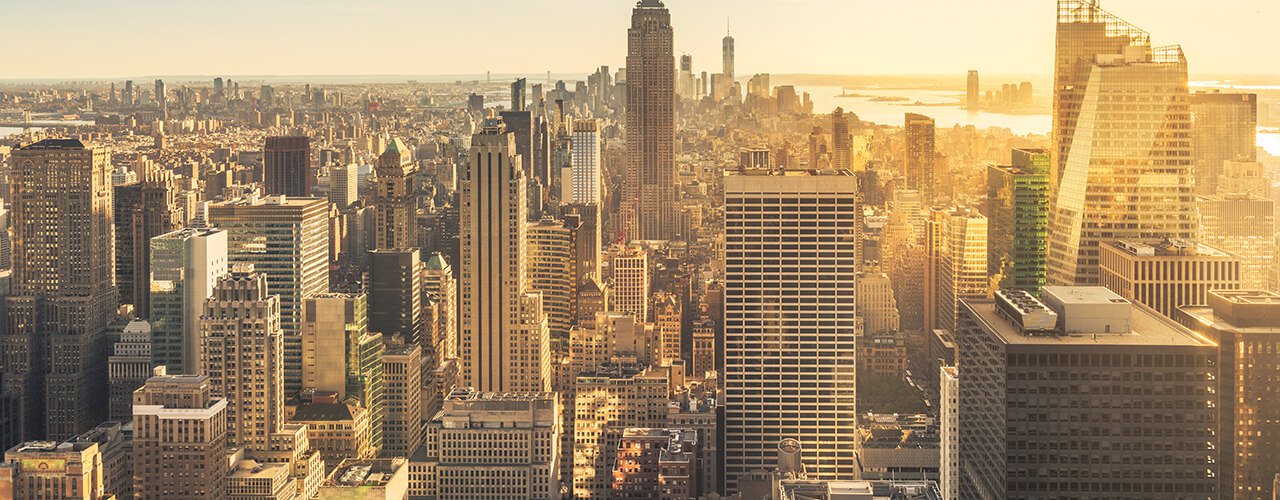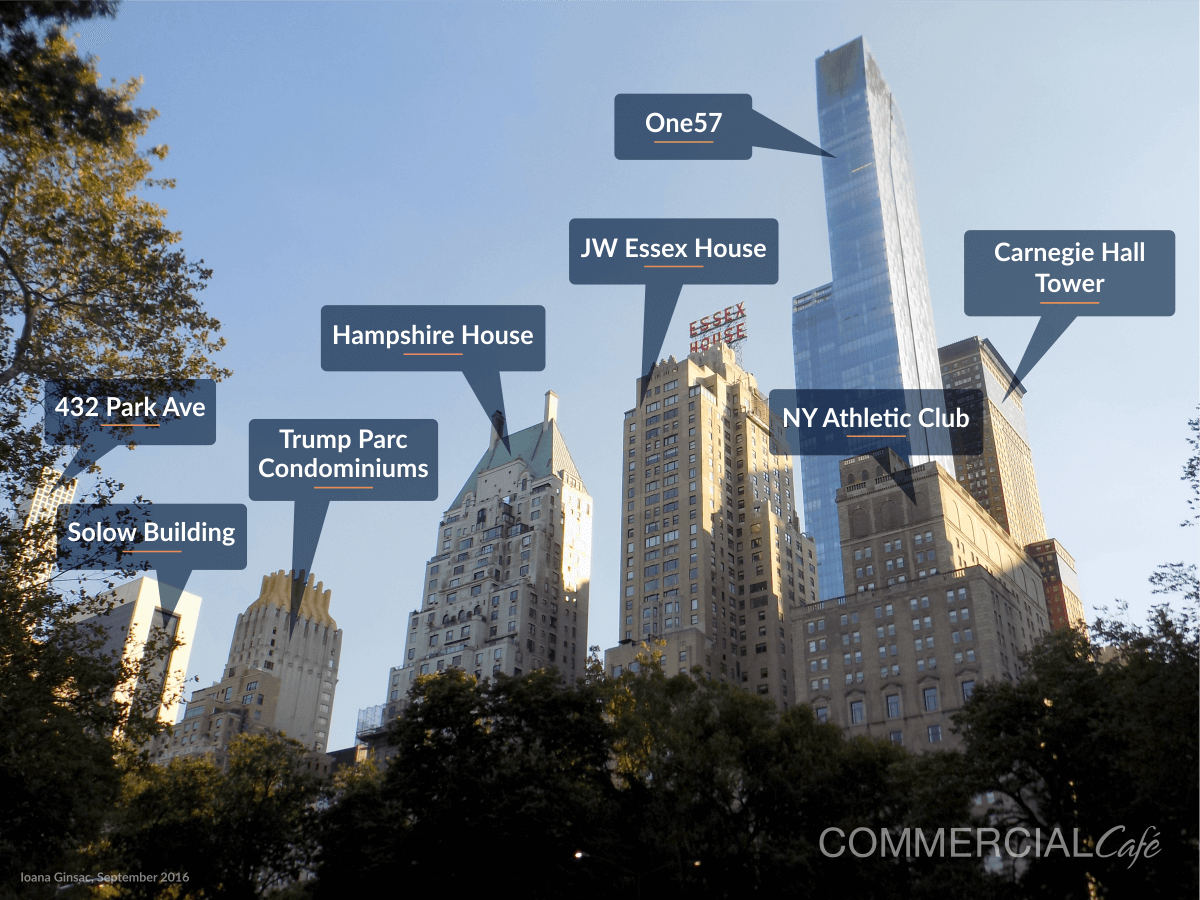At the close of 2018, we took our skyline series into New York City and looked at the evolution of the Lower Manhattan skyline. In part two, we focus on Midtown, specifically skyscrapers located between 14th and 59th streets. The short video included below presents a 110-year Midtown Manhattan skyline overview, which tracks the completion of buildings between 1908 through 2018 that are at least 500 feet tall.
Rows Of New York: The Glass Canyons That Make A City Unto Their Own
“New York is unlike any other place in the United States. We’ve tested everything first. All the great experiments of American society probably occurred here first. The rapid urban expansion and this experiment in multicultural societies came here first.” This remark – made by Professor Craig Steven Wilder in Ric Burns’ acclaimed documentary series – certainly rings true with respect to the city’s soaring architecture.
Between the late 1700s and early 1800s, the population of Manhattan nearly tripled. Officials were prompted to stay ahead of the wave by being prepared to accommodate the city’s future growth as best as they could. The Commissioner’s Plan of 1811 was a bold urban development outline that envisioned Manhattan’s street grid extending north from what is now Houston Street – then North Street – up to 155th Street, covering a vast rural area of streams, hills, and scattered farms and homes. The original Manhattan street grid filing remains largely the same to this day. While Lower Manhattan still preserves some of the tangled streetscape legacy of the city’s first generations of settlers, Midtown grew neatly into the organized street plan that invited Manhattan’s impressive urban expansion. By 1929, NYC was home to 15 towers that rose above 500 feet, while Chicago had only just begun to catch up.
Today, most of the tall and supertall structures in Midtown line avenues that seem to form a sort of backbone of the skyline. Perhaps the most famous of these corridors has formed along Sixth Avenue, the official name of which has still not caught on with New Yorkers in the 74 years since it was signed into law by Mayor La Guardia. The Fifth Avenue, Park, Lexington, and Madison corridors also help fill in the Midtown skyline, between Hell’s Kitchen and the East River.
Corporate Row
The NY Telephone Co. Tower (opened 1992, currently also known as 3 Bryant Park and Salesforce Tower), Grace Building (1972), and Bank of America Tower at One Bryant Park (2010) today stand as a gateway into “Corporate Row,” the tract of Sixth Avenue that runs above 42nd Street and is home to the towering offices of some of the world’s biggest corporate entities. The design of the Bank of America Tower was inspired by the Crystal Palace, which hosted the first world’s fair in 1853, where Bryant Park is now. Engineered to provide a healthy indoor environment, the tower offers some of the most environmentally advanced office space in New York City*. The street canyon of prestigious Midtown buildings continues towards Central Park South with the slender-figured Americas Tower (1992), the massive 1166 6th Ave., building (1974), and the Stevens Tower (1971).
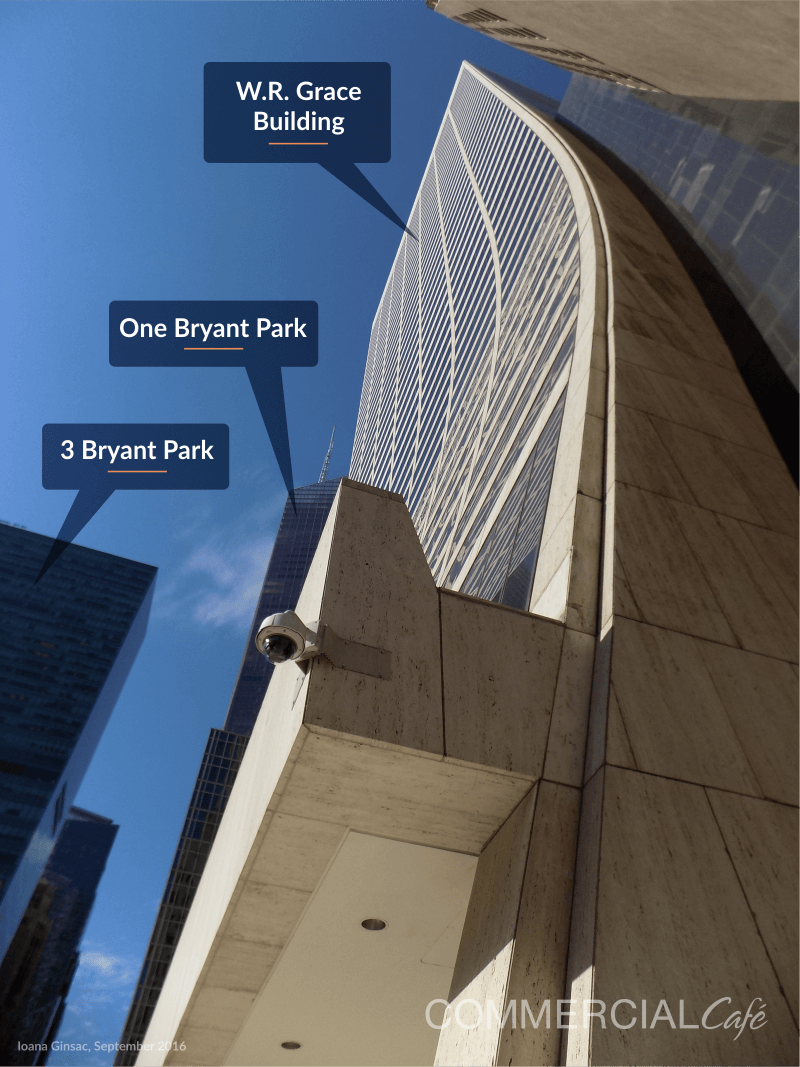
The Bryant Park gateway into Corporate Row: 3 Bryant Park (Salesforce Tower), One Bryant Park (Bank of America Tower), and the Grace Building
Though no longer the tallest in the pack, the Rockefeller Center buildings’ design will always stand out. Completed in multiple phases between 1932 and 1973, this architectural vision of a city-within-a-city encompasses 21 buildings and stretches several blocks on both sides of the thoroughfare. 30 Rock (1932) was the first piece of the grand Rockefeller 3D puzzle, and the Newscorp building (1973) was the 21st and last.
Beyond the Rockefeller Center, the buildings that line Sixth Avenue towards Central Park have a more corporate feel. The most prominent of these are the iconic CBS “Black Rock”, the Credit Lyonnais building, the Financial Times tower, and the New York Hilton Midtown – the largest hotel in the city, and the largest Hilton in the continental U.S.
Billionaires’ Row
90 years before the completion of 432 Park Avenue, currently the tallest residential high-rise in the Western Hemisphere, The Ritz opened and set a new standard for living comfort. In 1926, the corner of 57th and Park was the premier crossroads in Central Manhattan and the location where journalist and developer Arthur Brisbane built the most sought-after apartment hotel in the city.
Upon completion, the Emery Roth-designed tower was the tallest residential building in New York, offering panoramic views in all directions. Lavishly decorated both inside and out, the Ritz housed Le Pavillon, one of the first authentic French restaurants in the U.S., and attracted high-profile residents including actress Greta Garbo, publisher William Randolph Hearst, Jr., designer Valentino, and television producer Norman Lear.
In addition to cementing Emery Roth’s reputation as a designer of luxury housing, the Ritz Tower was arguably the first piece of what we now call “Billionaires’ Row,” the well-to-do enclave built around 57th Street, roughly along the southern edge of Central Park. Notable towers that have sprung up along this tract include the Metropolitan and Carnegie Hall towers – separated only by the 20-foot wide Russian Tea Room building – the Solow Building, on the façade of which Superman caught a jewel thief, and the Time-Warner Center, soon to be renamed for Deutsche Bank.
The firm that Emery Roth later established with two of his sons has designed over 100 Manhattan skyscrapers since World War II. This prolific portfolio includes Midtown icons like the Pan Am/MetLife Building (1963), 299 Park Avenue (1967), the General Motors Building (1968), Citicorp Center/601 Lexington (1977), and the New York Palace Hotel (1981).
Land Is Scarce, Views Are Precious, And No Skyscraper Is High Enough
Rising above the Midtown Manhattan skyscraper canopy today are seven supertall towers. The first to pierce through the 1,000-foot ceiling was the Chrysler Building, in 1930. During the late 1920s, the Golden Age of Art Deco skyscrapers, New York architects became obsessed with creating the tallest buildings in the world. William van Alen spurred on by Walter P. Chrysler, managed a unique feat of secret engineering while competing for the title with the Bank of Manhattan headquarters that was being simultaneously constructed at 40 Wall Street. The building’s recognizable top was handcrafted in sheet metal shops hidden on the 65th and 66th floors of the building. The spire was built there in secret and, in November 1929, was hoisted through the top of the building and assembled on site in roughly 90 minutes, to everyone’s surprise.
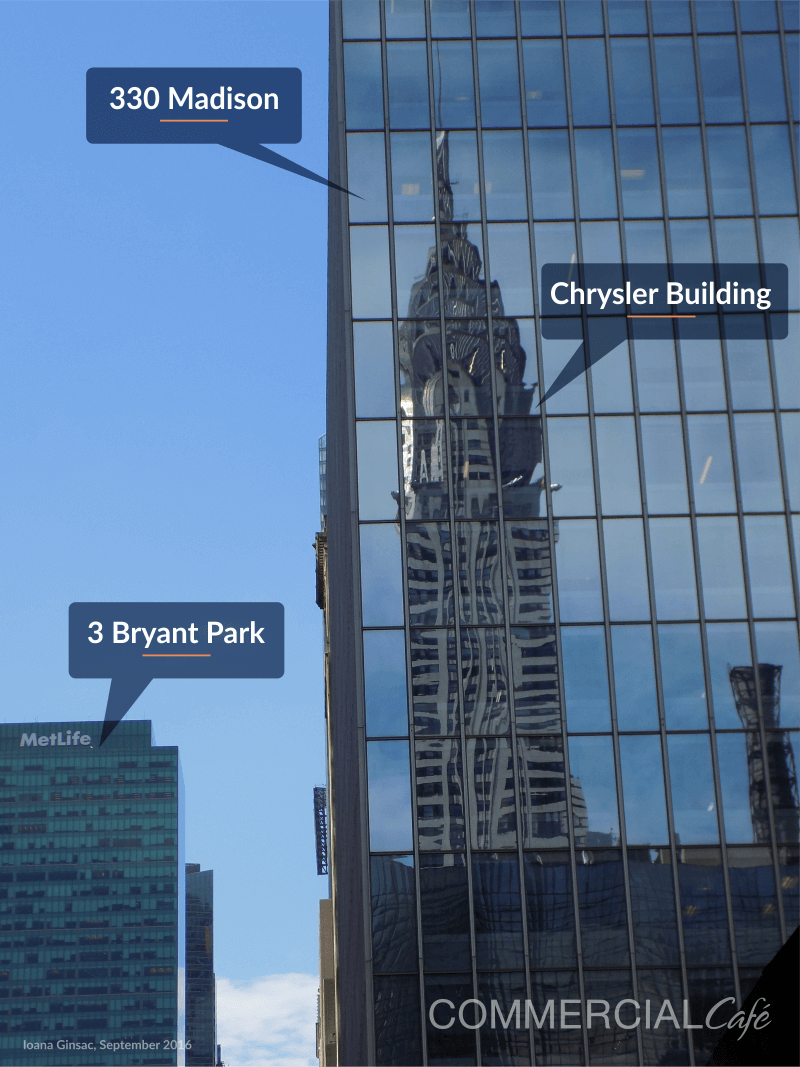
The Chrysler Building silhouette reflected in the facade of its neighbor, 330 Madison. The top of 3 Bryant Park, previously MetLife, now Salesforce Tower, to the far-left.
From its official finish date on May 27, 1930, until the completion of the Empire State Building on April 11, 1931, van Alen’s skyscraper held the title of the world’s tallest building. Although the Lower Manhattan skyline, followed by others around the world, have since broken the Empire State’s height record, no other Midtown building has yet risen above the tip of its spire (1,454 feet).
The first supertall development to come close was the 1,118-foot tall Condé Nast Building at 4 Times Square, which was completed in 1999. The New York Times building on Eighth Avenue opened in 2003, rising 1,046 feet. In 2010, the Bank of America tower on Sixth Avenue became the fifth supertall Midtown building, clocking in 1,200 feet in height. Four years later, Billionaires’ Row welcomed One57, its first skyscraper to rise above 1,000 feet. Finally, in 2016, the then-thinnest skyscraper in the world was built on the site formerly occupied by the historic Drake Hotel: 432 Park Avenue rises 1,397 feet and boasts a height-to-width ratio of 1 to 15.
Driven by the scarcity of land and a hunger for lofty views, more supertall, super-slender developments are in the making: 111 West 57th is a 1,428-foot tower slated for completion this year, and Central Park Tower, under construction at 217 West 57th St., and due in 2020, is shooting for the title of tallest residential building in the world, rising 1,550 feet above Midtown.
West Side Rising
Walking through West Midtown now, it may be hard to imagine that in the 1980s it was run-down and in dire need of an overhaul. A full-block, mixed-use development project was proposed at the start of the decade. In 1989, The Worldwide Plaza was finally completed – the first major commercial development west of Eighth Avenue, since 1931.
Most of the high-rise development in Midtown’s support district has been and continues to happen in the transition zones around Hell’s Kitchen. The Sheffield, designed by Emery Roth & Sons, opened in 1978 near Columbus Circle. Encompassing 845 apartments, it was one of the largest rental buildings in Midtown at the time. After being purchased in 2005, the property was converted into 580 luxury condos and integrated with the rest of Billionaires’ Row.
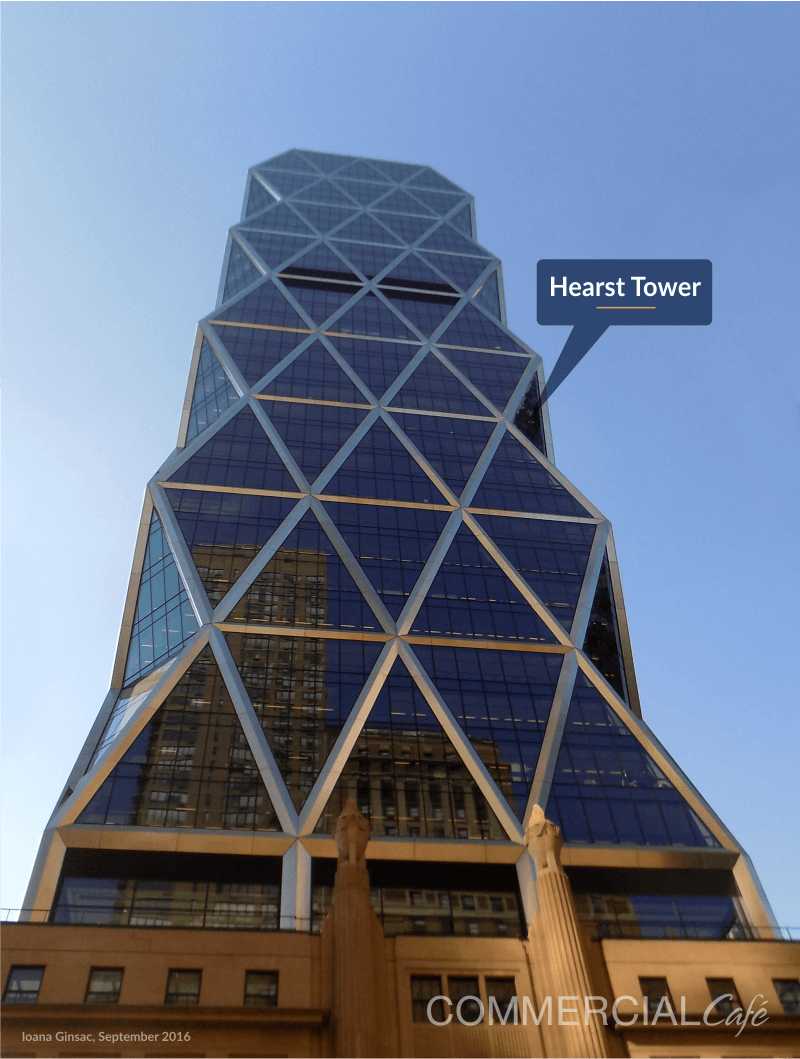
Hearst Tower, the country’s first triple LEED-certified building, earned BOMA NY’s 2018 Grand Pinnacle of the Year Award
Within a few years, the jagged silhouette of Hearst Tower rose next-door, in contrast not only to its surroundings but also to established building practices. The LEED Platinum-certified building was designed to use 20% less steel than conventional skyscraper frames would require**, and 90% of the steel that was used was sourced from recycled material. Several blocks South on Eighth Avenue, another newfangled business district tower had been erected – the 1.6 million-square-foot New York Times Building replaced 10 Times Square buildings that had been home to long-standing small local businesses.
Development moved further west in the transitional area between Hell’s Kitchen and Chelsea, with the completion of The Orion, a 604-foot tall luxury condominium building at West 42nd and Ninth. A slew of residential towers popped up further west on the boundary by 2010, banking on neighborhood redevelopment plans that aimed to extend the Midtown business district further towards the Hudson. The Atelier Condo, Silver Towers, and the Icon explored the ever thinner residential architecture that had taken over the town. Manhattan View at MiMA, Sky Luxury Rentals, and 555Ten soon added to the new extra tall residential stock of West Midtown.
One of the most dramatic slivers in town, the Icon was designed to appear almost moving, reflecting the intense energy of its environs.
The largest West Side revival currently in development is Hudson Yards. Filling in the skyline at the confluence of Hell’s Kitchen, Chelsea, and the Garment District, the mixed-use complex includes six buildings taller than 500 feet, two of which have already been completed: 10 Hudson Yards and 55 Hudson Yards. Three more towers are expected to be delivered this year: 15 Hudson Yards, 35 Hudson Yards, and 30 Hudson Yards, the tallest structure in the ensemble. So far, Midtown’s newest neighborhood has been keeping developers busy, with tenants flocking into the business district expansion, and the city is working away at infrastructure upgrades and additions in the area.
Methodology
For our Midtown Manhattan Skyline Evolution video, we turned to Yardi Matrix and Skyscrapercenter data and compiled a list of occupiable buildings that are at least 500 feet tall and located in Manhattan, above 14th Street and up to 59th Street. No building classes were excluded. Additional proprietary research was conducted for the body of the article.
* Dupré, J. (Black Dog & Leventhal Publishers, 2013) Skyscrapers, a History of the World’s Most Extraordinary Buildings, page 136
** Goldberger, P. (The Monacelli Press, 2009) Building Up and Tearing Down, Reflections on the Age of Architecture, page 149
Source and date of images: author, September 2016.

